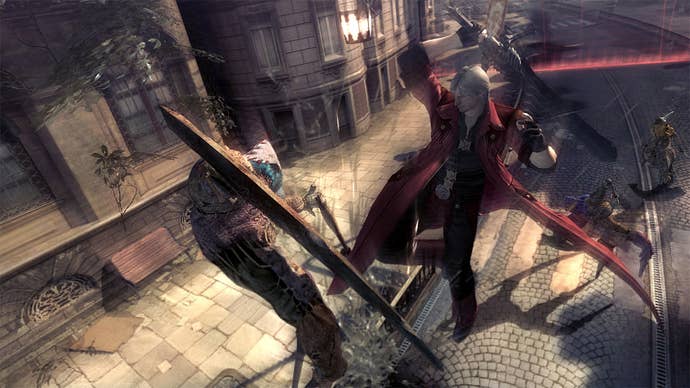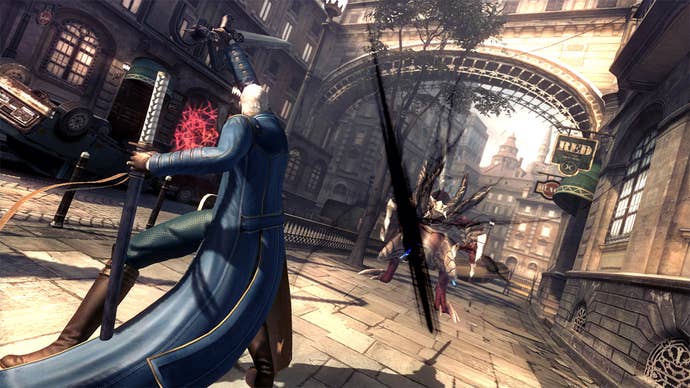Devil May Cry 4 Special Edition Xbox One Review: In the Details
Capcom might not have chosen the most deserving candidate for a next-gen makeover, but—if you can handle its last-gen baggage—Dante's late-aughts adventure provides reliable DMC action.
This article first appeared on USgamer, a partner publication of VG247. Some content, such as this article, has been migrated to VG247 for posterity after USgamer's closure - but it has not been edited or further vetted by the VG247 team.
I shouldn't need to tell you we've been caught up in a wave of last-gen rereleases. And while I'd much rather see developers put their efforts into making brand-new creations, the return of these old games hasn't been all bad news.
I'll admit, it's a bit annoying to see remakes show up just a year or two after the original release—for the most part, situations like this feel like a cynical solution to the Backwards Compatibility Problem. Still, I'd be lying if I said these rereleases didn't have their purpose; I missed out on 2013's Tomb Raider due to total apathy, recently grabbed the PS4 upgrade on the cheap, and got a chance to experience Lara Croft's umpteenth reboot in a moderately improved form. Everybody wins!

That said, 2008's Devil May Cry 4 sits in a strange spot when it comes to next-gen remakes: It's not quite old enough to be considered a classic, and not quite new enough for people to have just missed it. Yet, here we have its Special Edition, and though this isn't the best example of the "stylish action" genre, that fact that we don't see many games of its ilk in our modern age helps temper the original Devil May Cry 4's shortcomings... to a point.
Like the three games preceding it, Devil May Cry 4 focuses on acrobatic, combo-driven action and a relentless appraisal of your performance. Though the levels themselves range from creepy castles to idyllic forests, what you'll be doing in them doesn't really change: fighting handfuls of enemies within enclosed arenas. Once you develop a strategy for a particular foe, the real challenge comes in maintaining said strategy while you bounce from enemy to enemy and react to their changing behaviors on the fly. After a few hours with any Devil May Cry, it becomes a sort of zen-like experience as your thumbs and fingers begin to react instantly to the animations playing out on the screen. Though Capcom simply fell back on an established formula, the action in Devil May Cry 4 feels incredibly responsive, and I soon found myself falling into incredibly natural rhythms and racking up mega-combos without having to think too hard my next step.
While the series' trademark fast-paced combat remains incredibly reliable, Devil May Cry 4 unfortunately falls victim to Capcom's circa-2008 anxieties about HD development. Remember, it wasn't long ago when developers were first figuring out how to cope with the increased cost of development for HD consoles, and Devil May 4 attempts to address these concerns in some wrong-headed ways. Though their first idea isn't too bad: Since Devil May Cry has a reputation as a difficult series, DMC4 starts you off as Nero, a character with much more versatility—his grappling hook, which can pull him towards enemies or enemies towards him, definitely stands as one of the most useful weapons in the game. Even though Nero makes the demands of DMC a little easier to handle, his section of the main campaign still provides plenty of challenge, so his presence doesn't feel like much of a disruption.

Eventually, regular DMC protagonist Dante takes over where Nero left off, which brings us to the most unfortunate section of Devil May Cry 4. Instead of giving Dante his own set of levels and bosses, he simply retraces Nero's steps, trudging through the same environments and fighting the same bosses until the very end of the game. Sure, Capcom makes a few changes here and there (Now it's raining! Now there are traps on the floor!), but heading from Point A to Point B and back to Point A again ultimately feels like a disappointing journey. Even the revamped boss fights feel particularly undercooked, and not necessarily adjusted for Dante's abilities. Playing as Nero, the bosses gave me a legitimate challenge, but as Dante, I didn't have to do much outside of run up to them and slash away mindlessly.
And while every game should be judged by its own merits, these things don't exist in a vacuum, and some elements of Devil May Cry 4 seem absolutely ancient when compared to its spiritual successor, Bayonetta. Sure, the prescribed camera angles have always been part of DMC's adversarial stance towards the player—the series started life as a proposed Resident Evil game, after all—but on a modern system with semi-modern graphics, they feel particularly out-of-place. Chunks of the environment love to get in the way of battles, and the camera has a tendency to switch angles so your movement controls are completely reversed after passing a certain threshold. Devil May Cry IV's camera also does a wonderful job of interfering with the minor exploration and platforming challenges the game presents, making it somewhat miserable when you're not occupied with the one thing Devil May Cry IV excels at: doing absolutely ridiculous things with equally ridiculous weapons.

Thankfully, Capcom's special edition does an admirable job of bringing Devil May Cry 4 up to modern standards. The frame rate stays at a solid 60 FPS, and, despite its seven years on this planet, DMC4 still looks pretty damned good. It's not going to measure up to current-gen releases, of course, but its out-there design choices (along with some downright tacky ones) make up for the lack of spiffy, modern effects. And there's some new content to be had this time around, too: Lady and Trish can be used throughout the campaign, as can Nero—all of these folks making their first appearance in older games—and while they all play pretty differently, the essential experience remains the same. The biggest downside of these new playable characters, though, is that you need to start their campaigns from the beginning, regardless of where you are in another character's. So, if you reach Mission 8 with Nero and Dante, and want to see how Lady and Trish handle the same level, you'll need to work your way up to that point with the female twosome independently. That's a lot of added repetition for a game that's kind of built around this aspect in the first place.
I may sound a little harsher on Devil May Cry 4 Special Edition than my review score lets on, but, as a latecomer to last-gen who missed its original release entirely, I definitely had a worthwhile time. Yeah, the presence of Bayonetta and its sequel do a great job of highlighting the many tedious parts of DMC4, but underneath all of that remains what I love most about the series: a highly technical and extremely reliable combat system that's always fun to dip back into.
InterfaceDevil May Cry is a series that demands precision, and thankfully, the controls are intuitive and responsive. (Though I did miss having a single-button dodge move a la Bayonetta.)
Lasting AppealDMC4's Special Edition contains 3 campaigns with unique character but not unique levels. Only Devil May Cry aficionados will bother to work their way through all of them, but that's been true of most of the series' bonus/extra content.
VisualsA lot can happen in seven years, though the original DMC4's graphics hold up pretty well. At their worst, the game's visuals are at least presentable.
ConclusionIf you pick up Devil May Cry 4 Special Edition, know that you're essentially getting a prettier version of a 2008 experience. That may sound extremely obvious, but, over the last seven years, character action games have changed greatly, making some of DMC4's choices feel absolutely dated. If you can get past these qualities, though, you'll find the same reliable action we've come to expect from Devil May Cry over the past 15 years.
